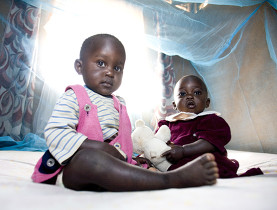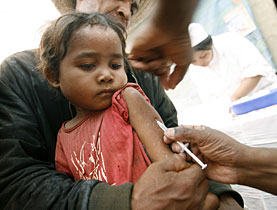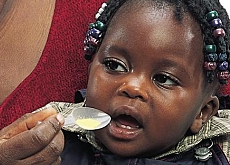Malaria funds start biting, but slowly

Malaria has become fashionable among donors who are now pumping billions of dollars into the fight against the disease with encouraging successes.
However, eradication is still a long way off. Experts from Swiss public and private institutions tell swissinfo why more money is needed and that funding alone will not be enough to eliminate a disease that kills more than one million people a year.
The experts, Christian Lengeler of the Swiss Tropical Institute (STI) and Hans Rietveld of the pharmaceutical giant Novartis, represent two organisations that have joined forces to raise awareness of the need for greater action to control malaria.
They are members of the Swiss Malaria Group, which, among others, includes the chemical companies, Syngenta and Mepha, and the Geneva-based Medicines for Malaria Venture.
Two current methods of keeping the killer disease in check are the use of insecticide treated bed nets, and treatment of the disease with drugs containing artemisinin, including Novartis’ product Coartem. Novartis sells the drug at cost.
Yet according to STI, which is actively involved in a treatment programme in Tanzania, as few as ten-20 per cent of the population in rural areas in the country, receive appropriate and timely treatment.
swissinfo: Is the problem of distribution and access one of the key issues to be resolved if malaria is to be controlled effectively?
Hans Rietveld: In general distribution is a key challenge. Malaria in most of the sub-Saharan countries is the biggest public health problem. Given the structures of healthcare delivery it is still a tall order to get effective medicines to everybody who needs them. It’s becoming better in urban areas, and there’s lots of progress in rural areas as well. But we are faced with roads that during the rainy season might not be accessible, to mention just one of the challenges. The good news is that since 2001, Novartis has provided more than 160 million treatments – without profit – to those most in need.
swissinfo: STI has begun a programme to improve access. How can the distribution of treatments be improved?
Christian Lengeler: It’s very clear that there are a lot of different aspects that need to be considered. Interestingly our findings so far are that patients do the right thing. They recognise the disease correctly and take the correct action. But it’s really the health system that lets them down. They don’t get access to the right drug or they don’t get the right dose.
swissinfo: What needs to be done?
C.L.: It’s about improving management and quality of care. And paradoxically everyone knows how the system should work.
swissinfo: There are still more than one million people dying a year of malaria even though hundreds of millions of dollars are being thrown at the disease annually compared with a few tens of millions in the 1990s.
H.R.: There’s much more money available than ever before and that’s very positive but it is true that countries have limited absorptive capacities to responsibly spend all the donor funding that is currently available.
It comes down to whether there is adequate staffing and whether the health structure and entire infrastructure can be improved, so there is still a long way to go. But we also see successes in the fight against malaria. Several countries have reported quite recently that they are seeing a decline in mortality rates.
swissinfo: Which countries?
H.R.: For example, Rwanda, Ethiopia and Zambia. And these reductions in mortality can really be attributed to better prevention methods and better drugs being utilised.
swissinfo: How significant have the reductions been in those countries?
H.R.: From 33 per cent mortality reduction in Zambia to 66 per cent mortality reduction in Rwanda.
C.L.: I agree entirely that we have problems using the available resources but it’s important to remember that we now have a spending level of about $2 billion per year for malaria control. But there are two billion people at risk from malaria so it still means only $1 per person per year.
swissinfo: That’s enough for one treatment of Coartem.
C.L.: It’s enough for one treatment, or a third of a bed net. We are not yet in the right financial dimension. And it will take time because countries cannot absorb everything in one go. But we still need to have more funds.
swissinfo: The largest private donor, the Bill and Melinda Gates Foundation, is now calling for efforts to focus on malaria eradication. But critics say striving to achieve this goal will mean less funding for measures needed now to control the disease.
H.R.: I think one has to be ambitious setting goals especially since we were successful in eradicating malaria in Europe. But in the African setting it will be very complex to achieve that.
C.L.: It’s not achievable with the current tools we have so we need to have better tools. We will need a vaccine, we will need genetically engineered mosquitoes, we will need better insecticides and we will need a good pipeline of different drugs because insecticide and drug resistance are a real threat within the next five to ten years. If we see it as a goal for the next 30-40 years, it’s probably achievable, but if we set it as a goal for the next ten years it’s impossible.
swissinfo-interview: Dale Bechtel
Malaria is caused by a parasite of the Plasmodium species and is transmitted by the bite of a female Anopheles mosquito.
It kills more than 1 million people a year and is a major cause of anaemia, low birth weight, premature birth, infant mortality and maternal deaths.
The first ever World Malaria Day will be held on April 25.
The group counts 11 members from the public and private sector, including pharmaceutical and agribusiness companies, charities and research and development assistance institutes.
Three aims of the group are to raise awareness of the efforts required to combat the disease effectively, encourage more funding and to highlight innovations and initiatives coming out of Switzerland.
Insecticide-treated bed nets and indoor spraying of houses with insecticides are two effective methods to keep the Anopheles mosquito at bay.
The Intermittent Preventive Treatment strategy is the delivery during routine vaccinations of an anti-malarial drug to pregnant women and infants at high risk of malarial infection.
Currently, the most effective drugs are combination treatments containing artemisinin – derived from a plant that has been used for centuries in traditional Chinese medicine to treat fever. One such drug is Coartem, produced by Novartis.

In compliance with the JTI standards
More: SWI swissinfo.ch certified by the Journalism Trust Initiative












You can find an overview of ongoing debates with our journalists here . Please join us!
If you want to start a conversation about a topic raised in this article or want to report factual errors, email us at english@swissinfo.ch.